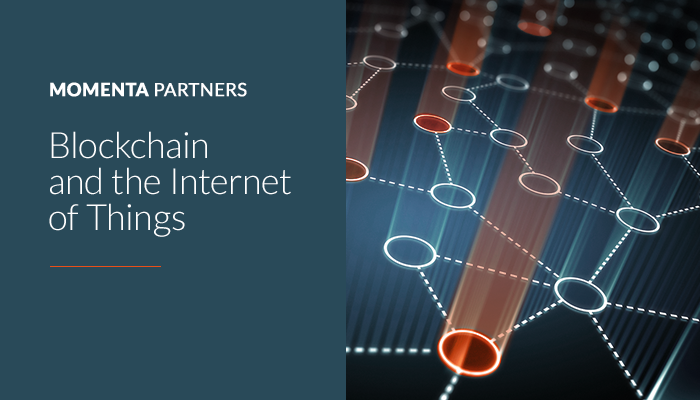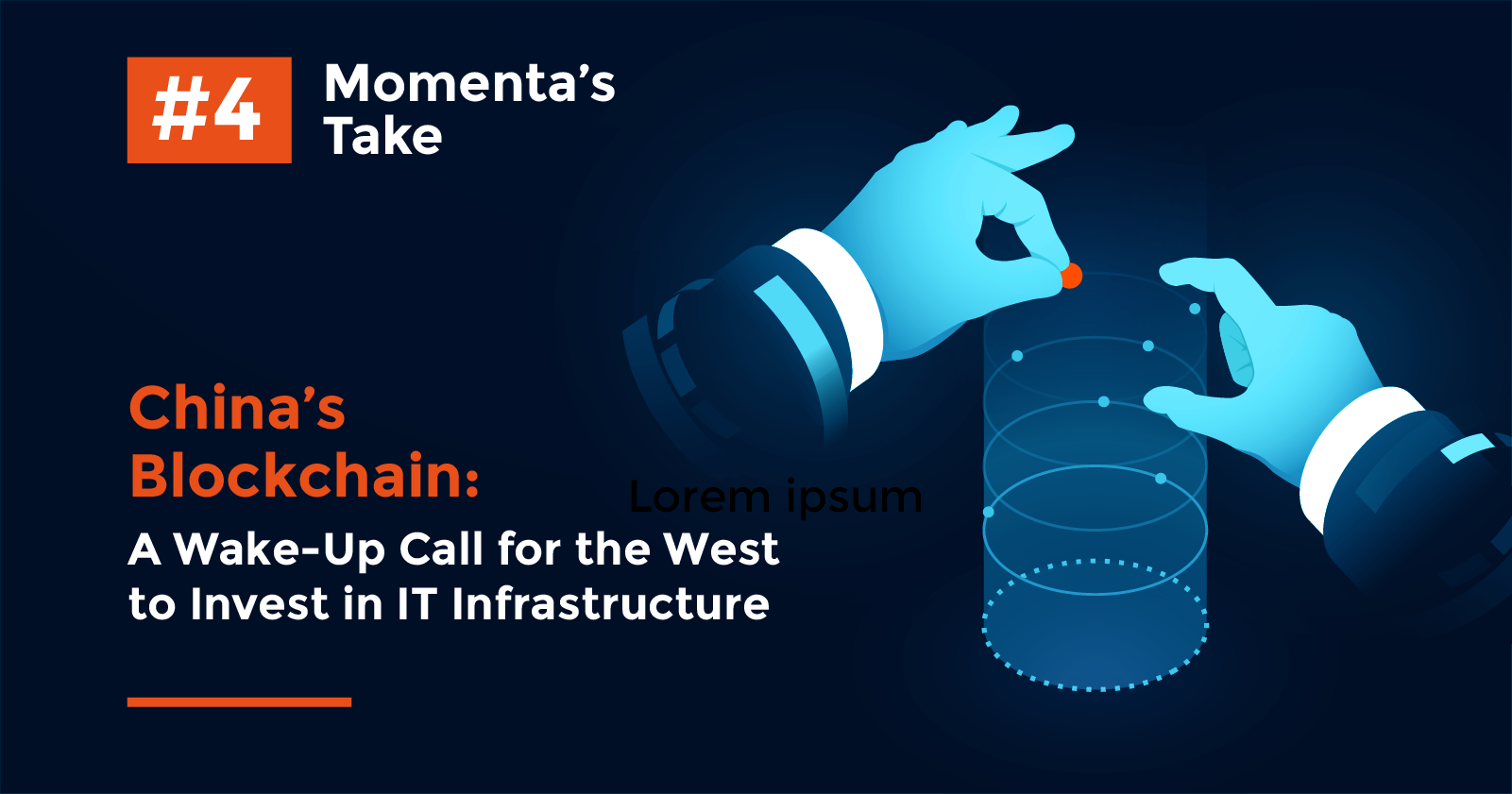Value Vector
Blockchain and the Internet of Things
Ed Maguire

With the price of Bitcoin and other cryptocurrencies like Ether hitting record highs, and with ICO’s (Initial Coin Offerings) raising more money than VC investments, we may be approaching peak hype around Bitcoin and the underlying technology known as blockchain.
Investments frenzies are often accompanied by skepticism – and this applies to use in the Internet of Things. "Internet of Things is when your toaster mines Bitcoins to pay off its gambling debts to the fridge” tweeted by American professor Andrew Miller in jest, highlights how odd Bitcoin and IoT can seem at first. Nonetheless, there’s growing interest in more practical uses of blockchain technologies for Internet of Things applications, and while we are still in the very early stages of the market there are some promising initiatives underway. At Momenta Partners we’re optimistic about the long-term potential for blockchain, though the current speculative frenzy may lead to disenchantment in the medium term.
Why the IoT creates new challenges in security, scalability, and trust
What distinguishes IoT from prior waves of computing evolution is the massive scale of connected devices expected to come online. This introduces new challenges including identifying, connecting, securing, and managing devices that are orders of magnitude greater than before. The traditional broker-based networking model, where devices rely on a central cloud server to identify and authenticate individual devices is not designed to support highly scalable IoT ecosystems of the future. Not only does a centralized model become expensive when it comes to computation, but it’s also a potential bottleneck and security risk, subjecting networks to disruption from Denial of Service attacks that bring down servers by overwhelming them with a flood of requests.
How will it be possible to verify and track billions of transactions between millions of different nodes on a network? How will it be possible to manage micro-payments, cross-border and machine-to-machine transactions without overwhelming traditional intermediaries like carriers, banks, and credit card companies, or regulatory authorities? How will it be possible to establish networks in industrial settings where IoT nodes are spread expand over wide areas with scarce connectivity?
Blockchain technologies offer promise to scalable IoT networks
Blockchain technologies make it possible to create dynamic mesh networks, where IoT devices can securely interconnect while reducing vulnerability to device spoofing and impersonation threats. With every legitimate node registered on the blockchain, devices would be able to identify and authenticate one another without using a centralized broker or certification authority, scaling to billions of devices without additional resources. Blockchain networks can provide a way to track the history of individual devices by recording the data exchanges with other devices, people, and services. Blockchains could also allow smart devices to act as autonomous agents, conducting a range of transactions independently.
A brief overview of blockchain
Blockchain is a distributed, secure platform – essentially an immutable database running on potentially billions of devices - purpose-built for money and value and also for storing data and building applications. Just like the internet is usable by everyone and owned by nobody, the blockchain is the same. Blockchain is a type of Distributed Ledger Technology - a database with copies of all transactions maintained by all participants in the network. Blockchains are a peer-to-peer mesh of users and decentralized processing nodes where every participant is both a consumer and server of resources on that network. A key feature is the consensus formation algorithm which validates that a transaction is acceptable by having a majority of participants agree. In most systems, there is a validation process – in the case of Bitcoin, this is computational work to come to a consensus regarding storage and transmission of value – which is expressed in the form of a bitcoin token.
Trust and integrity - architected into the system
The system is designed so no trust is needed, it’s built into the architecture of the system. In contrast to traditional centralized networks, with blockchain applications, every node sees everyone else’s transaction. The integrity of the blockchain protocol prevents any duplication, so theoretically there’s no opportunity for fraud or double-counting of transactions, as is the case with credit cards. For each new input, nodes check every other transaction in what is called the “blockchain”. Consequently, transactions can be conducted directly and securely between two strangers – with no intermediaries. This approach is highly suited to large IoT device networks.
What are key IoT use cases for blockchain?
There’s an extraordinary range of use cases enabled by blockchain that would have been impossible before the invention. Smart contracts can help exchange money, property, shares, or anything of value. A simple example of a smart contract is when vending machine counts coins inserted by the customer, then dispenses the item. Blockchain allows smart contracts to be executed automatically using the software. Uses for smart contracts in IoT could include edge devices purchasing algorithms or data in real-time, or sensors selling data, buying data storage space or bandwidth on demand, drones paying delivery tariffs for cross border delivery, and other uses.
Another use case is tracking the lineage of goods to prevent theft, spoilage, and counterfeiting and to ensure the integrity of products. Walmart is working with IBM and Beijing’s Tsinghua University to track the movement of pork in China with a blockchain. Mining company BHP Billiton is using blockchain to track mineral analysis done by outside vendors.
There are industrial uses as well. IBM has been working with Finnish startup Kouvola Innovation and Maersk to enable automated ships to pass their cargo from country to country recorded in cryptographically secure ledgers as sensors track their presence. Startup Filament provides devices that create low-power autonomous mesh networks for industrial applications, using a bitcoin blockchain for device identification and intercommunication.
The technology can also be used in next-generation energy grids, tracking the exchange of credits and debits among networks of solar and battery enabled participants that both produce and consume energy. LO3 Energy is working on the Microgid and Transactive Grid projects in Brooklyn, which enable neighbors to sell excess solar energy to one another on a community grid, dynamically tracking transactions on an Ethereum based blockchain.
Still early days, but innovations are active
There’s an enormous amount of blockchain-based startup activity, while companies like Microsoft and IBM are already offering blockchain as a service offering online. One of the challenges in using the Bitcoin network is that it can take up to 10 minutes to validate a transaction. There are tradeoffs between immutability (how tamper-proof the network is) and the speed and intensity of computation required.
There is a lot of innovation of “side-chains” –overlay networks with much lower latency that can be used for specialized purposes. IOTA’s Tangle architecture is a peer-to-peer network designed for speed with far less computational overhead than Bitcoin. IBM and Samsung have created ADEPT (Automated Decentralized P2P Telemetry) a decentralized IoT system designed for billions of devices to broadcast transactions between peers and perform self-maintenance. While no one knows exactly where the value of Bitcoin will end up, or whether the current trading frenzy around ICOs will ultimately end up in a crash, the industrial IoT uses offers serious enough promise that major tech firms are taking meaningful steps to advance the technology. Expect that in 10-20 years blockchain may be as common as databases in the era of Connected Industry.
At Momenta we’re optimistic about the long-term potential for blockchain as a key enabling component of scaling the Industrial IoT and Connected Industry.
Contact us to learn more about blockchain technology, or any of our IoT Thought Leadership capabilities.



